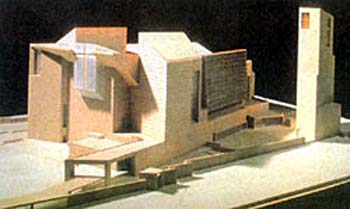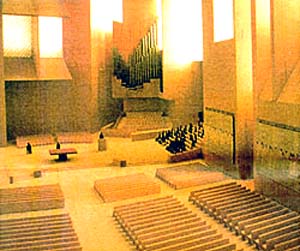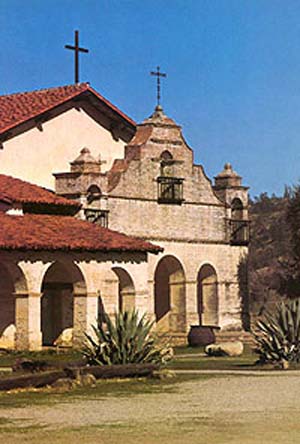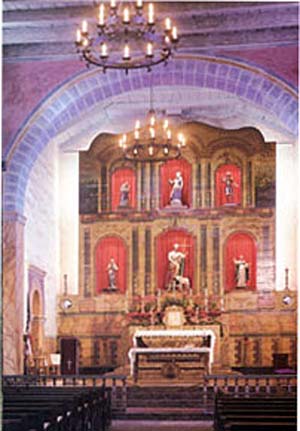 |
Art & Architecture
The Poor Church of the Rich and
the Rich Church of the Poor
Marian T. Horvat, Ph.D.
It fell to the fourth Archbishop of Los Angeles, Cardinal Roger Mahony, to realize Southern California’s goal of some ninety years to build a new Cathedral. Since Pius X gave his permission in 1904 for the Spanish-style Cathedral of St. Vibiana’s to be replaced, various sites were chosen and attempts made to begin the project. Therefore, when plans were unveiled last year for the new Cathedral of Our Lady of the Angels in downtown Los Angeles, there was the normal expected applause from the normal in-tune-with-the-times civil leaders and diocesan sycophants.

A draft of the new Los Angeles cathedral.
Cost is estimated at around $200 million |
After all, this would be one of the largest cathedrals in the United States, only slightly smaller than New York’s St. Patricks, and would be designed by a Pulitzer Prize wining architect imported from Spain. After all, it would have space for 3,000 “congregants” and a 3-acre plaza, a conference center, a residence for the Cardinal, and a 600-car underground garage. After all, with a price tag of close to $200 million, making it the nation’s most expensive Catholic cathedral, it would surely be a great work of art, the best money could buy.
But the simple soul imbued with the Catholic spirit needs only a quick look at the plans for the Cathedral of Our Lady of the Angels to see the truth of the matter. Like the innocent boy in the fairy tale who watched the pompous cortege parading in the streets around its king bedecked in new expensive royal robes, he calls out: “But the Emperor has no clothes.” It is a naked cathedral, devoid of sacrality and the Catholic spirit. In short, it is a pagan edifice.
A building or work of art is not Catholic by the simple fact of bearing the name on a placard outside. The soul that breathes in the work of art must be Catholic, illuminating all that it touches. The spirit that inspired the exterior of this gigantic concrete building can justly be called extravagant, but certainly not Catholic. There is no unity, no harmony, no coherence. It looks as if a California earthquake had already struck the area, distorting the building and throwing its blocks in all directions.

The interior: A convention hall or a place of worship? |
The most striking factor about the interior of the new “Cathedral of Lights” is its total failure to achieve its ultimate aim. A cathedral is above and beyond all else superbly attuned to the worship of God. It provides a climate of meditation and calm, and offers a place for man to fall on his knees, the noblest position of worship for a human being. Mahony’s barren cathedral completely lacks the atmosphere of recollection necessary for prayer.
There are benches, but no kneelers. The table at the front is the only sign that this might be the place for a Mass to be said, but even then it might just as well be a pamphlet table for some immense new convention hall. The light entering the alabaster windows breaks into an interior with a single undefined earth tone with tinges of yellow and orange, producing a depressing impression of a desert. There are no visible side altars sheltering the Crucifix, Our Lady, the angels and the saints, and no religious symbols to be seen anywhere. (A curious detail: the very name cathedral signifies the church that has the Bishop’s cathedra, or chair, the symbol of his power to govern, teach and sanctify. Yet there is no noticeable cathedra for this strange “cathedral.”)
Another egalitarian feature: there is no clear division between the supposed presbytery (the area with the “altar”) and the part that is occupied by the faithful. Even the organ is not ordered by a monarchic principle. The pipes that normally rise heavenward in a kind of gothic arch have been rearranged to form what looks like a broken Y. It is a fundamentally inconsistent building in view of the traditional rules that have governed the construction of a church: an area exclusively for the faithful, an area for the clergy to carry out the sacred rites, and the “Sancta Sanctorum” – the Tabernacle – the place for Our Lord in the Eucharist.

San Antonio de Padua Mission represents the true Catholic spirit |
In short, from the outside, it is a monstrous edifice, and from the inside, a pagan one. It is a cathedral clearly intended to portray a desacralized and poor church. Alas! Such an incredible sum of money to produce such a monument of incoherence and miserablism. This is the price of some of the false ideals of the Conciliar Church.
This is a building designed to welcome the pan-religionist and relativist man of the 21st century, but not God. One can not even find the Tabernacle, which used to crown the main altar and dominate the sanctuary of every Catholic church. Near the end of the Gospel of John, Mary Magdalene discovers the empty tomb of Christ, runs to the disciples and says to them “They have taken away the Lord, and we know not where they have laid him!” Searching for the unrecognizable and abandoned Tabernacle in the new cathedral, the faithful of Cardinal Mahony’s diocese must feel much the same way.
What a world of difference between the disjointed Los Angeles Cathedral and this simple but noble San Antonio de Padua Mission Church in Monterey County, California. This mission church, the third one founded by Fr. Serra in 1771, has been completely restored, with little that different from the mission days. The church is well known for its simple but charming campanario, or bell holder, located directly in front, the bells hanging in the wall over the arches.
How different from the extravagent and unrecognizable bell tower of the new Los Angeles cathedral! This mission church was certainly not expensive, but it was nonetheless beautiful, and endures today as an authentic representation of a region and a people.

San Juan Bautista Mission, built in 1797. A simple majesty turned toward God |
The interior of San Juan Bautista mission (below) is the largest of the California mission churches, the only one with three iseles. It is neither lavish nor splendorous. But its noble simplicity and ordered beauty reflect well the exalted function for which it was built: worship. A sacral spirit invites those who enter to repose, meditation, prayer, and above all, to adore Our Lord in the Sacrifice of the Holy Mass and in the Eucharist. The characteristic mission frontispiece forming the main altar shelters images of Our Lady and the saints. Over the altar and Tabernacle, the crucified Christ reminds us of the Man of Sorrows who took upon Himself the sins of all and inspires contrition.
The Missions San Antonio de Padua and San Juan Baptista, like all the California Mission Churches, were forced to a certain simplicity given the situation of Spain’s dwindling resources and commitments to projects in the New World. Nonetheless, it is clear that they are imbued with the wealth and munificence of the Catholic spirit, which marks even the most simple of her edifices.
The new Los Angeles Cathedral has a price tag of almost $170 million, but it is a pathetically poor church, a church stripped of her rich and glorious liturgy, symbols and heritage, a church that speaks the impoverished common language of a secularized world.
The small two-centuries-old Mission Churches obviously cost much less to construct, but they are remarkably rich Churches, replete with Catholic symbols and spirit, that continues to this day to speak the sublime language of spiritual serenity and sacrality.


More on this Topic
 Where Have All the Real Saints Gone?
Where Have All the Real Saints Gone?

|
Art & Architecture | Hot Topics | Home | Books | CDs | Search | Contact Us | Donate

© 2002-
Tradition in Action, Inc. All Rights Reserved
|
 |
|